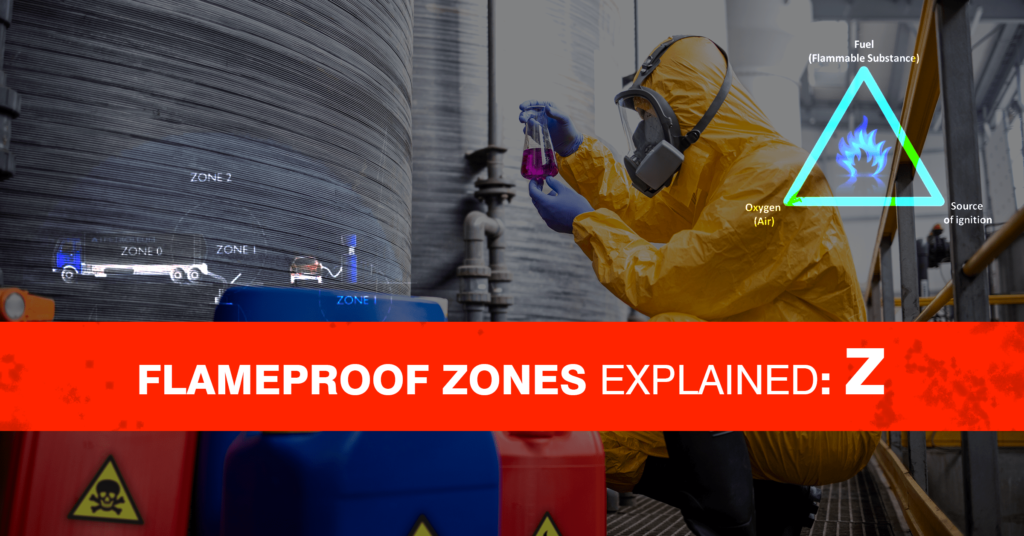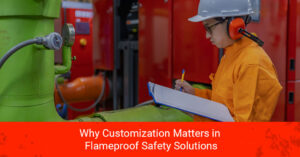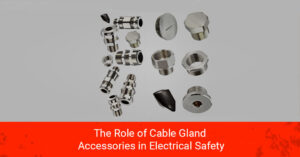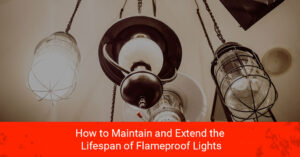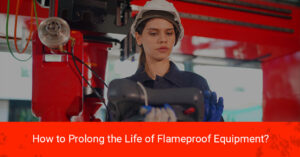Welcome to our detailed guide on Flameproof Zones. We will understand various aspects of flameproof zones to ensure a thorough understanding of the critical safety areas in hazardous environments.
When you are around flammable or explosive substances on a daily basis, safety becomes an unwavering priority. Explosions in these high-risk areas can have disastrous results. Strict guidelines and classifications have been established to mitigate these risks.
Understanding the Building Blocks of an Explosion
Before discussing flameproof products and areas, let’s understand the fundamental elements required for an explosion to occur. An explosion requires the convergence of three essential factors:
- Flammable Substance: Enough flammable substances, such as gases, vapours, mists, or dust, are usually present for an explosion to occur. These substances serve as the explosion’s fuel.
- Oxygen: These combustible substances need a lot of oxygen to combine and create an explosive atmosphere. The oxidiser in this combustion process is oxygen.
- Ignition Source: By igniting the flammable mixture, an ignition source, such as a spark or intense heat, serves as the explosion’s trigger.
These three substances come together in a combustible environment to create a potentially fatal scenario.
To prevent fires and explosions in such circumstances, special precautions must be taken. To prevent sparks that might ignite flammable compounds, electronic equipment, including lighting, must be correctly built.
Flameproof Zone Classification
Based on the frequency and duration of explosive atmospheres existing, hazardous regions are split into various zones for appropriate management and classification.
The three main zone classifications for gases, vapors, and mists are Zone 0, Zone 1, and Zone 2. Let’s examine each zone in more detail:
Zone 0
Zone 0 is defined as a place where an explosive environment exists constantly for lengthy periods of time or happens often. This zone is the most dangerous because explosive conditions are always present, making it an extremely dangerous location. Working in Zone 0 requires specific equipment and strict safeguards.
Zone 1
An explosive environment is more likely to appear sporadically during routine operations in Zone 1. This may be the consequence of maintenance tasks, repairs, or the release of combustible material.
Zone 2
During normal operations, an explosive environment is unlikely to arise in Zone 2. However, if such an environment does emerge, it will only last for a short time. These regions become dangerous only in the case of an accident or unexpected operating conditions.
Zone 2 has a lower danger rating than the other zones, although safety measures and equipment compatibility are still required.
Illustrating Flameproof Zones: A Real-World Scenario
To better grasp these classifications, let’s consider a typical petrol station as an example. Within the station, various areas can be categorised as Zone 0, Zone 1, or Zone 2.
Zone 0
Zone 0 includes the immediate area surrounding the fuel pumps when petrol vapours are always present. Because of the continual presence of an explosive environment, this region at a gas station presents the greatest risk.
Zone 1
The vicinity of the petrol pumps and the filling station, where there is occasional presence of petrol vapours while refuelling, is designated as Zone 1. Zone 1 has a smaller risk than Zone 0, although safety measures are still necessary.
Zone 2
The parking lot and the convenience store are examples of places where explosion-proof products such as explosion-proof panels, explosion-proof junction boxes, and control stations, are present during normal business hours. Only in the case of accidents or extraordinary situations do these regions become dangerous.
Lighting Considerations for Flameproof Zones
Given the critical necessity of safety in hazardous areas, illumination is critical. Lighting fixtures in flameproof zones must meet particular requirements in order to reduce the danger of fire while delivering appropriate illumination.
The following are important factors to consider when selecting lighting for various flameproof panels and zones:
1. Zone Classification Awareness
It’s important to understand the exact zone classification of the region where flameproof lights will be put. The degree of safety measures and protection necessary for lighting equipment is determined by this categorisation.
2. Specialised Luminaires
It’s critical to use lighting equipment made for dangerous environments. These luminaires are intended to stop sparks or intense heat from igniting combustible materials. For example, the Raytec SPARTAN line has specific luminaires for Zone 1 and Zone 2 locations.
3. Colour Coding for Identification
Flameproof luminaires are frequently color-coded to make it easier to identify various degrees of protection. For instance, zone one fittings may be silver, zone two fittings might be dark grey, and zone three fittings might be white. Red end caps on emergency versions may be included to show that an emergency battery backup is there.
4. Part Code Differentiation
Part codes for lighting fixtures also vary depending on the level of protection required. For instance, SPARTAN’s Zone 1 fixtures have part codes beginning with SPX, Zone 2 with SPZ, and industrial products with SPI prefixes.
5. Zone 0 Considerations
Zone 0, being the most hazardous area, is typically associated with gas storage or containment. In such cases, lighting is often employed on a small and portable basis for visual inspection, such as headlamps. It’s important to note that Raytec does not currently offer lighting solutions for Zone 0 due to its unique requirements.
Check out our latest blog –A Comprehensive Guide On Flameproof Control Stations
Conclusion
The categorisation of flameproof zones is critical in hazardous industrial settings for maintaining safety and limiting the danger of explosions. Understanding the components of an explosion, as well as the features of Zone 0, Zone 1, and Zone 2, is critical for a full risk assessment.
When designing illumination for these zones, it is critical to use specialized luminaires built for hazardous environments. These luminaires avoid the possibility of sparks or high heat igniting combustible material, thus minimizing the risk of explosions.
If you are looking to enhance your business safety, Bharat Flameproof is a leading manufacturer of flameproof products. All our products such as Flameproof distribution boards, flameproof fans, flameproof control stations, etc. are suitable for Zone 1 & 2.
Also, if you want to know more about flameproof products, we have published a dedicated blog on the Misconception of Flameproof products to provide you with a better perspective.
FAQs
Flameproof Zones are essential for ensuring safety in industries like mining and petrochemicals because they prevent explosions while also safeguarding people, property, and the environment.
Managing Flameproof Zones requires the use of specialist tools, enclosures, and safety precautions to lessen ignition risks, adhere to safety standards, and limit the likelihood of catastrophic events.

